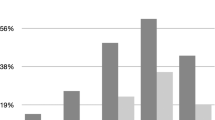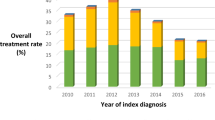Abstract
Study design:
Prospective.
Objectives:
To test whether provocative stimulation of the testes identifies men with chronic spinal cord injury (SCI), a population in which serum testosterone concentrations are often depressed, possibly due to gonadal dysfunction. To accomplish this objective, conventional and lower than the conventional doses of human chorionic gonadotropin (hCG) were administered.
Methods:
Thirty men with chronic SCI (duration of injury >1 year; 18 and 65 years old; 16 eugonadal (>12.1 nmol l−1) and 14 hypogonadal (⩽12.1 nmol l−1)) or able-bodied (AB) men (11 eugonadal and 27 hypogonadal) were recruited for the study. Stimulation tests were performed to quantify testicular responses to the intramuscular administration of hCG at three dose concentrations (ithat is, 400, 2000 and 4000 IU). The hCG was administered on two consecutive days, and blood was collected for serum testosterone in the early morning prior to each of the two injections; subjects returned on day 3 for a final blood sample collection.
Results:
The average gonadal response in the SCI and AB groups to each dose of hCG was not significantly different in the hypogonadal or eugonadal subjects, with the mean serum testosterone concentrations in all groups demonstrating an adequate response.
Conclusions:
This work confirmed the absence of primary testicular dysfunction without additional benefit demonstrated of provocative stimulation of the testes with lower than conventional doses of hCG. Our findings support prior work that suggested a secondary testicular dysfunction that occurs in a majority of those with SCI and depressed serum testosterone concentrations.
Similar content being viewed by others
Log in or create a free account to read this content
Gain free access to this article, as well as selected content from this journal and more on nature.com
or
References
Bauman WA, La Fountaine MF, Spungen AM . Age-related prevalence of low testosterone in men with spinal cord injury. J Spinal Cord Med 2014; 37: 32–39.
Clark MJ, Schopp LH, Mazurek MO, Zaniletti I, Lammy AB, Martin TA et al. Testosterone levels among men with spinal cord injury: relationship between time since injury and laboratory values. Am J Phys Med Rehabil 2008; 87: 758–767.
Durga A, Sepahpanah F, Regozzi M, Hastings J, Crane DA . Prevalence of testosterone deficiency after spinal cord injury. PMR 2011; 3: 929–932.
Schopp LH, Clark M, Mazurek MO, Hagglund KJ, Acuff ME, Sherman AK et al. Testosterone levels among men with spinal cord injury admitted to inpatient rehabilitation. Am J Phys Med Rehabil 2006; 85: 678–684.
Naderi AR, Safarinejad MR . Endocrine profiles and semen quality in spinal cord injured men. Clin Endocrinol 2003; 58: 177–184.
Tenover JL . Therapeutic perspective: Issues in testosterone replacement in older men. Can replacement doses of testosterone produce clinically meaningful changes in body composition in older men? J Clin Endocrinol Metab 1998; 83: 3439–3440.
Auyeung TW, Lee JS, Kwok T, Leung J, Ohlsson C, Vandenput L et al. Testosterone but not estradiol level is positively related to muscle strength and physical performance independent of muscle mass: a cross-sectional study in 1489 older men. Eur J Endocrinol 2011; 164: 811–817.
Hintikka J, Niskanen L, Koivumaa-Honkanen H, Tolmunen T, Honkalampi K, Lehto SM et al. Hypogonadism, decreased sexual desire, and long-term depression in middle-aged men. J Sex Med 2009; 6: 2049–2057.
Gray A, Feldman HA, McKinlay JB, Longcope C . Age, disease, and changing sex hormone levels in middle-aged men: results of the Massachusetts Male Aging Study. J Clin Endocrinol Metab 1991; 73: 1016–1025.
Friedl KE, Moore RJ, Hoyt RW, Marchitelli LJ, Martinez-Lopez LE, Askew EW . Endocrine markers of semistarvation in healthy lean men in a multistressor environment. J Appl Physiol (1985) 2000; 88: 1820–1830.
Isidori AM, Lenzi A . Risk factors for androgen decline in older males: lifestyle, chronic diseases and drugs. J Endocrinol Invest 2005; 28 (3 Suppl): 14–22.
Daniell HW . Hypogonadism in men consuming sustained-action oral opioids. J Pain 2002; 3: 377–384.
Bauman WA, La Fountaine MF, Cirnigliaro CM, Kirshblum SC, Spungen AM . Provocative stimulation of the hypothalamic-pituitary-testicular axis in men with spinal cord injury. Spinal Cord 2016; 54: 961–966.
Padron RS, Wischusen J, Hudson B, Burger HG, de Kretser DM . Prolonged biphasic response of plasma testosterone to single intramuscular injections of human chorionic gonadotropin. J Clin Endocrinol Metab 1980; 50: 1100–1104.
Smals AG, Pieters GF, Drayer JI, Benraad TJ, Kloppenborg PW . Leydig cell responsiveness to single and repeated human chorionic gonadotropin administration. J Clin Endocrinol Metab 1979; 49: 12–14.
Okuyama A, Namiki M, Koide T, Itatani H, Mizutani S, Sonoda T et al. A simple hCG stimulation test for normal and hypogonadal males. Arch Androl 1981; 6: 75–81.
Forest MG, Lecoq A, Saez JM . Kinetics of human chorionic gonadotropin-induced steroidogenic response of the human testis. II. Plasma 17 alpha-hydroxyprogesterone, delta4-androstenedione, estrone, and 17 beta-estradiol: evidence for the action of human chorionic gonadotropin on intermediate enzymes implicated in steroid biosynthesis. J Clin Endocrinol Metab 1979; 49: 284–291.
Brackett NL, Lynne CM, Weizman MS, Bloch WE, Abae M . Endocrine profiles and semen quality of spinal cord injured men. J Urol 1994; 151: 114–119.
Munro D, Horne HW Jr, Paull DP . The effect of injury to the spinal cord and cauda equina on the sexual potency of men. N Engl J Med 1948; 239: 903–911.
Horne HW, Paull DP, Munro D . Fertility studies in the human male with traumatic injuries of the spinal cord and cauda equina. N Engl J Med 1948; 239: 959–961.
Bors E, Engle ET, Rosenquist RC, Holliger VH . Fertility in paraplegic males; a preliminary report of endocrine studies. J Clin Endocrinol Metab 1950; 10: 381–398.
Ver Voort SM . Infertility in spinal-cord injured male. Urology 1987; 29: 157–165.
Beretta G, Chelo E, Zanollo A . Reproductive aspects in spinal cord injured males. Paraplegia 1989; 27: 113–118.
Linsenmeyer TA . Male infertility following spinal cord injury. J Am Paraplegia Soc 1991; 14: 116–121.
Huang HF, Li MT, Giglio W, Anesetti R, Ottenweller JE, Pogach LM . The detrimental effects of spinal cord injury on spermatogenesis in the rat is partially reversed by testosterone, but enhanced by follicle-stimulating hormone. Endocrinology 1999; 140: 1349–1355.
Meeker JD, Godfrey-Bailey L, Hauser R . Relationships between serum hormone levels and semen quality among men from an infertility clinic. J Androl 2007; 28: 397–406.
Sina D, Schuhmann R, Abraham R, Taubert HD, Dericks-Tan JS . Increased serum FSH levels correlated with low and high sperm counts in male infertile patients. Andrologia 1975; 7: 31–37.
Subhan F, Tahir F, Ahmad R, Khan ZD . Oligospermia and its relation with hormonal profile. JPMA J Pak Med Associ 1995; 45: 246–247.
Jensen TK, Andersson AM, Jorgensen N, Andersen AG, Carlsen E, Petersen JH et al. Body mass index in relation to semen quality and reproductive hormones among 1558 Danish men. Fertil Steril 2004; 82: 863–870.
Krausz C . Male infertility: pathogenesis and clinical diagnosis. Best Pract Res Clin Endocrinol Metab 2011; 25: 271–285.
Storer TW, Woodhouse L, Magliano L, Singh AB, Dzekov C, Dzekov J et al. Changes in muscle mass, muscle strength, and power but not physical function are related to testosterone dose in healthy older men. J Am Geriatr Soc 2008; 56: 1991–1999.
Tuck SP, Francis RM . Testosterone, bone and osteoporosis. Front Horm Res 2009; 37: 123–132.
Finkelstein JS, Yu EW, Burnett-Bowie SA . Gonadal steroids and body composition, strength, and sexual function in men. N Engl J Med 2013; 369: 2457.
Bhasin S, Storer TW, Berman N, Callegari C, Clevenger B, Phillips J et al. The effects of supraphysiologic doses of testosterone on muscle size and strength in normal men. N Engl J Med 1996; 335: 1–7.
Snyder PJ, Bhasin S, Cunningham GR, Matsumoto AM, Stephens-Shields AJ, Cauley JA et al. Effects of testosterone treatment in older men. N Engl J Med 2016; 374: 611–624.
Cherrier MM, Anderson K, Shofer J, Millard S, Matsumoto AM . Testosterone treatment of men with mild cognitive impairment and low testosterone levels. Am J Alzheimers Dis Other Demen 2015; 30: 421–430.
Smith HS, Elliott JA . Opioid-induced androgen deficiency (OPIAD). Pain Physician 2012; 15 (3 Suppl): ES145–ES156.
Rubinstein A, Carpenter DM . Elucidating risk factors for androgen deficiency associated with daily opioid use. Am J Med 2014; 127: 1195–1201.
Perkash I, Martin DE, Warner H, Blank MS, Collins DC . Reproductive biology of paraplegics: results of semen collection, testicular biopsy and serum hormone evaluation. J Urol 1985; 134: 284–288.
Hayes PJ, Krishnan KR, Diver MJ, Hipkin LJ, Davis JC . Testicular endocrine function in paraplegic men. Clin Endocrinol 1979; 11: 549–552.
Huang TS, Wang YH, Chiang HS, Lien YN . Pituitary-testicular and pituitary-thyroid axes in spinal cord-injured males. Metabolism 1993; 42: 516–521.
Kikuchi TA, Skowsky WR, El-Toraei I, Swerdloff R . The pituitary-gonadal axis in spinal cord injury. Fertil Steril 1976; 27: 1142–1145.
Morley JE, Distiller LA, Lissoos I, Lipschitz R, Kay G, Searle DL et al. Testicular function in patients with spinal cord damage. Horm Metab Res 1979; 11: 679–682.
Glass AR . Pituitary-testicular reserve in men with low serum testosterone and normal serum luteinizing hormone. J Androl 1988; 9: 224–230.
Gregory SJ, Kaiser UB . Regulation of gonadotropins by inhibin and activin. Semin Reprod Medi 2004; 22: 253–267.
Bilezikjian LM, Blount AL, Donaldson CJ, Vale WW . Pituitary actions of ligands of the TGF-beta family: activins and inhibins. Reproduction 2006; 132: 207–215.
Iliadou PK, Tsametis C, Kaprara A, Papadimas I, Goulis DG . The Sertoli cell: novel clinical potentiality. Hormones 2015; 14: 504–514.
Tenover JS, Bremner WJ . Circadian rhythm of serum immunoreactive inhibin in young and elderly men. J Gerontol 1991; 46: M181–M184.
Chong YH, Pankhurst MW, McLennan IS . The daily profiles of circulating AMH and INSL3 in men are distinct from the other testicular hormones, inhibin B and testosterone. PLoS ONE 2015; 10: e0133637.
Wang QF, Farnworth PG, Findlay JK, Burger HG . Inhibitory effect of pure 31-kilodalton bovine inhibin on gonadotropin-releasing hormone (GnRH)-induced up-regulation of GnRH binding sites in cultured rat anterior pituitary cells. Endocrinology 1989; 124: 363–368.
Winters SJ, Pohl CR, Adedoyin A, Marshall GR . Effects of continuous inhibin administration on gonadotropin secretion and subunit gene expression in immature and adult male rats. Biol Reprod 1996; 55: 1377–1382.
Acknowledgements
The authors thank the James J Peters VA Medical Center, Bronx, NY, USA, and the Kessler Institute for Rehabilitation, West Orange, NJ, USA for their support. This work was supported by the Department of Veterans Affairs, Veterans Health Administration, Rehabilitation Research & Development Service by funding through the National Center for the Medical Consequences of Spinal Cord Injury (B2648-C, B4162-C & B9212-C, and B2020-C).
Author information
Authors and Affiliations
Corresponding author
Ethics declarations
Competing interests
The authors declare no conflict of interest.
Rights and permissions
About this article
Cite this article
Bauman, W., La Fountaine, M., Cirnigliaro, C. et al. Testicular responses to hCG stimulation at varying doses in men with spinal cord injury. Spinal Cord 55, 659–663 (2017). https://doi.org/10.1038/sc.2017.8
Received:
Revised:
Accepted:
Published:
Issue date:
DOI: https://doi.org/10.1038/sc.2017.8
This article is cited by
-
Sexual Health in the Neurogenic Patient
Current Bladder Dysfunction Reports (2020)
-
Longitudinal Examination of Bone Loss in Male Rats After Moderate–Severe Contusion Spinal Cord Injury
Calcified Tissue International (2019)
-
Administration of increasing doses of gonadotropin-releasing hormone in men with spinal cord injury to investigate dysfunction of the hypothalamic–pituitary–gonadal axis
Spinal Cord (2018)



